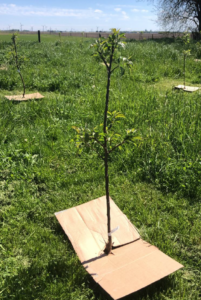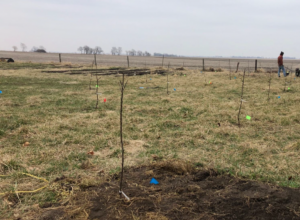Final report for FNC21-1315
Project Information
We are operating on about 20 acres of land. The land is family owned (by the Zumwalt Family), but is primarily farmed by the Zumwalt Acres Farm Apprentices who live, learn, and work on the farm during the fall, spring, and summer seasons. Zumwalt Acres was founded in August of 2020 by Gavi and Remi Zumwalt Welbel who are 6th generation farmers on the land. Prior to August 2020, the land was being conventionally farmed in corn and soy. In our first season, we grew 80 different vegetable crops including carrots, radishes, tomatoes, cucumbers, kale, cabbage, bok choy, potatoes, peppers, broccoli, okra, sweet corn, eggplant, green beans, and squash. Our fruit crops included watermelon, cantaloupe, strawberries, and blackberries. A large portion of produce was donated to local food pantries (serving 30-50 food insecure individuals each week) and consumed by our team of young farm apprentices. We also sold our horticultural crops through a regenerative farmer cooperative in Illinois called Down at the Farm. We planted a diverse agroforestry system of over 1,000 trees and shrubs, including paw paws, chestnuts, hazelnuts, pecans, peaches, honeyberries, apples, pears, apricots, nectarines, persimmons, elderberries, black currants, aronia berries, and serviceberries. Additionally, we grew 12 acres of alfalfa, timothy, and oats as a transition crop. Hay and straw was utilized for mulching our trees and crops, and sold to local farmers. Oats were sold to another farmer as cover crop seed. Prior to receiving this grant, we had just begun our regenerative farming initiative but we were already in the process of initiating numerous regenerative techniques such as low/no till farming, utilizing cover crops, incorporating soil amendments such as biochar and basalt, cultivating an agroforestry system (including two shelterbelts), and prioritizing native and perennial species in our agroforestry and horticultural crops .
The existing Midwestern agricultural model of monoculture corn and soybean row crops is failing our environment: it degrades fertile soils, contaminates water, and emits greenhouse gases. Alternative, regenerative models of agriculture, such as agroforestry paired with biochar production, capture carbon while rebuilding soils, suppressing pests and diseases, increasing biodiversity, and creating wildlife habitats. These techniques have been modeled from techno-economic, ecological, and social perspectives, but we plan to corroborate these models through field-based studies. Funding is necessary to finance initial tree planting and continuous maintenance of the agroforest. A kiln with the capacity to regenerate the soil of our 12-acre agroforest is also necessary. Furthermore, using a new retort kiln as well as our current Open Flame Curtain kiln will allow us to expand the body of literature on biochar production. By combining biochar production with agroforestry, we can create a closed system in which waste products from the agroforest (i.e. tree prunings, nutshells) are used as feedstock to produce biochar, which is then reincorporated into the soil. Currently, knowledge of biochar production conditions and uses is limited, especially in conjunction with agroforestry.
- For our windbreak, we will plant 330 chestnut trees in two rows of a quarter mile and 264 elderberry shrubs in one row. In preparation for forest farming, we will plant 18 each of hazelnut, persimmon, cider apple, and Asian pear trees. Trees will be planted with and without biochar as a soil amendment.
- Quantitatively determine difference in survival rate and growth in trees planted with and without biochar.
- Compare quality of biochar produced from wood waste in a retort kiln and in a “Kon-tiki” open flame-curtain kiln.
- Share findings through media (website and social media), research presentations, and educational outreach.
Cooperators
- (Educator)
- (Educator)
- (Researcher)
- (Researcher)
- (Researcher)
Research
Current research indicates that biochar increases tree health and captures carbon, therefore, our research focuses on the integration of biochar in agroforestry establishment. Additionally, agroforestry waste products (i.e., tree prunings and nutshells) are well-suited as biochar feedstock.
We will conduct field trials in our windbreak and orchard by planting equal numbers of trees in control plots of untreated soil and experimental plots with biochar application. We received consultation on tree species for the windbreak and orchard from the Natural Resource Conservation Service (NRCS) and the Savanna Institute, respectively.
One quarter mile of trees in the windbreak will serve as our test plot. This windbreak will be planted through CP5A - Field Windbreak with support from Thad Eshleman, our local NRCS representative. By beginning with a windbreak under Conservation Reserve Program (CRP) contract and transitioning into alley cropping, we can demonstrate how conventional farmers can use CRP funding to increase tree planting and regenerative practices while maintaining profits from commodity crops in the majority of the field.
In addition to the windbreak, we will plant a variety of trees in a 100’ x 175’ orchard to assess success rates with different species, before integrating into forest farming. Tree species will include cider apples, persimmon, Asian pears, and hazelnuts. In both the windbreak and the orchard, changes in soil health, tree health, and tree growth will be monitored.
Biochar used in experimental tree planting will be produced from hardwood in a retort kiln and inoculated by mixing with composted manure and soil, covered with water, and aerated for 5-7 days. As a result of lack of forest management and Emerald ash borer, there are dead trees on-site that can be used as feedstock until we have established an agroforest.
Data was collected on our shelterbelts and experimental fruit trees 2-6 times a season. Qualitative data collection for all trees included noting which trees had survived to first spring (and, eventually, second spring); health of tree including pest damage, leaf health, and sapling ability to support itself; and general field needs, such as mowing, mulching, etc. Quantitative data was collected on our experimental fruit and nut trees, which included Asian pears, American persimmons, three apple varieties, and hazelnuts. We elected to conduct four smaller the field trials on different species, rather than one larger field trial on the same species, to both observe if some species respond significantly to biochar as a soil amendment, and also to have a variety of fruits and nuts to offer to our community when the trees mature. Species were chosen primarily to cultivate native varieties when available, and to supplement with non-native trees to increase our product diversity in the years to come.
We are expecting to see fruits developing on these trees sometime between 2024-2026. To account for land usage without product yield, we implemented an alley cropping system on our asian pear and persimmon orchards. Between these trees, we grew winter and summer squashes, leafy greens, tomatoes, root vegetables, and more, harvesting hundreds of pounds of produce from these orchards. Compared to the hazelnut and apple orchards, which were not alley cropped, the pear and persimmon growth did not seem to be hindered by the vegetable production occurring between them, and, if anything, tending to the land around the trees kept these trees better mulched and weeded, and made managing these trees easier in a 1000+ tree agroforestry system. Thus, we recommend to any farmer who is considering incorporating trees into their agricultural system to employ the alley cropping method to reduce land space costs and ease farm management. In areas of the farm that were less suited to alley cropping, we planted trees where grass had previously been and we left the grass surrounding the trees, mowing it when necessary to avoid shading the young trees.
Rather than a retort kiln, we compared biochar made in a Rotatable Covered Cavity (RoCC) kiln, and in an open-flame Kon-Tiki kiln because Paul Anderson, inventor of the RoCC kiln, offered us a free kiln and to demonstrate how to best use it. We noticed that the resulting biochar appeared similar between the two kilns. We have not yet been able to conduct lab analysis on the RoCC biochar to compare with the analysis of the Kon Tiki biochar analysis. One benefit to the RoCC kilns was that larger wood could be used, requiring less manual chopping prior to burning. However, there was more smoke and the kiln was more difficult to interface with as people conducting burns.
As noted in our initial application and midterm report, we want to carefully consider in the reporting of data that in field trials of scale this small, it is difficult to produce statistically significant results. However, based on our qualitative and quantitative data, we can comfortably say that biochar as a soil amendment did not hinder the tree growth, and, if anything appears to have supported it.
To further explain this, let’s analyze the quantitative data collected from American persimmons, which were planted in September of 2021. Please refer to the table below, which has some of the data points from the beginning and end of the 2021 and 2022 growing seasons. Rows highlighted in red indicate experimental trees. All measurements are given in inches.
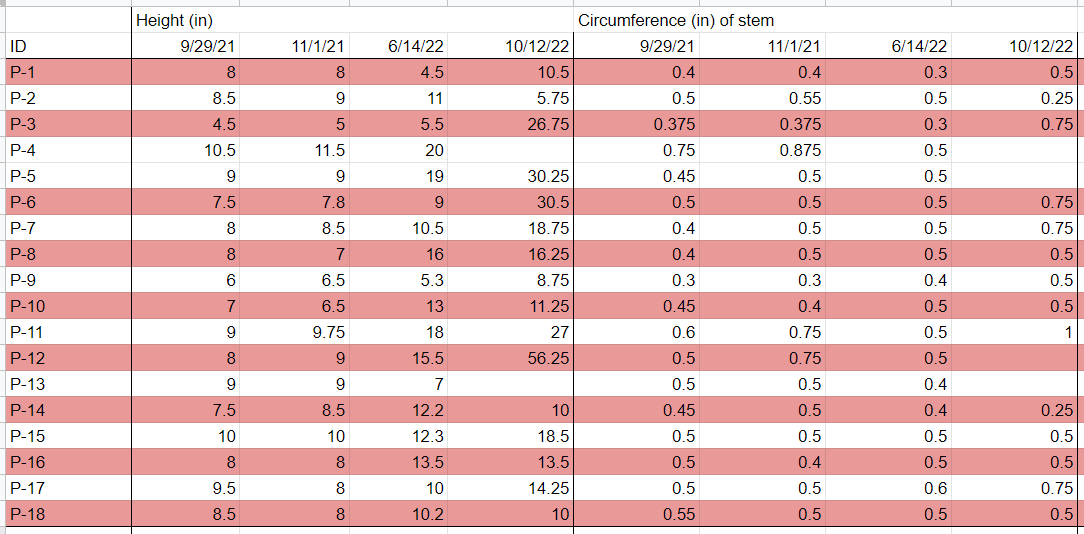
It’s evident that there is a wide range in tree health and growth both within and across the experimental and control trees. Note the differences in tree height between P-5 and P-2, as well as between P-12 and P-18. That said, on average, the trees planted with experimental values of biochar grew faster. Average growth in height from 9/29/21 to 10/12/22 was 14.3 inches for our experimental trees, compared to 6.6 inches in our control trees. Also, notably, while all trees made it to the first spring, two control trees did not make it past the fall of 2022.
Based on the height data of our 18 apple trees of the ‘Goldrush’ cultivar, it is difficult to produce statistically significant results due to the small sample size and time frame. The table and graph below show our results. Control lines are indicated in black and biochar treatment lines are indicated in red. Overall, all trees demonstrated relatively consistent growth with no strong outliers. The average height at the beginning of the period was 49.3 inches for both control and treatment trees; 109.7 inches and 110.3 inches, respectively, for control and treatment trees at the end of the period. Trees between the two groups did not demonstrate any notable differences in herbivory and foliar health. The plastic tubes that encased each tree for protection against large herbivores likely provided a sheltered environment for pests, with no significant distance between each tree for pests to travel.
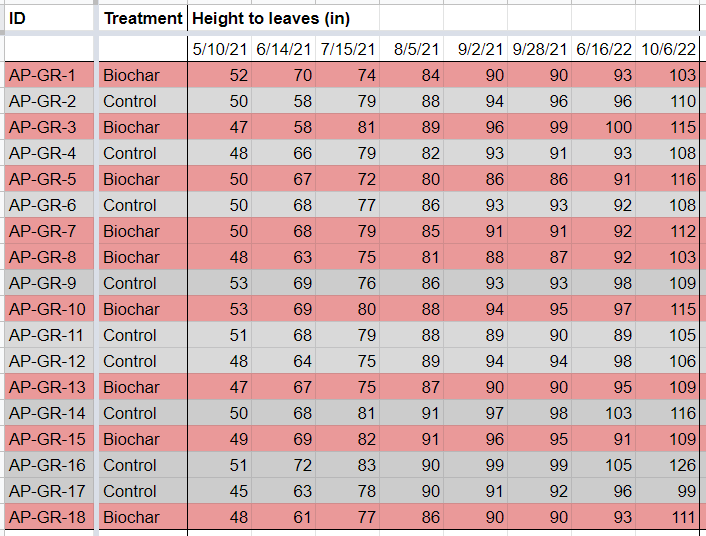
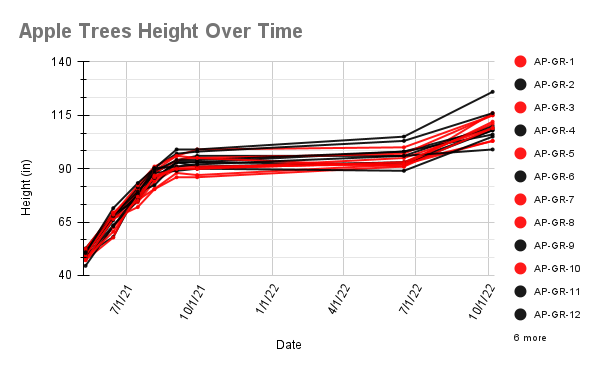
We intend to continue gathering quantitative and qualitative data on all of our trees as they mature to continue observing the effects of biochar as a soil amendment.
As part of our mission to build a better food system and tackle climate change, we hosted several field days and community events in partnership with The Land Connection, Savanna Institute, and Yale University, bringing in around 70 community members, farmers, and scientists to tour our farm and agroforest, learn about our climate solutions, and build local and regional relationships.
Educational & Outreach Activities
Participation Summary:
We have consulted with approximately 8-10 farmers and ranchers about incorporating biochar and basalt into their farming operation. We have succeeded in implementing basalt field trials on 5 farmers' plots of land.
We have created numerous fact sheets and presentations on the regenerative practices we implement, including: the soil health and carbon capture benefits of biochar and basalt, integrated agroforestry systems, regeneratively grown and chemical free horticulture, low/no till soil practices, and cover cropping.
We have had approximately 6 biochar demonstrations in which we have taught farm apprentices, regional farmers, and community members how to produce biochar.
We have published numerous articles on our regenerative farming practices, carbon capture research, apprenticeship program, and intentional queer Jewish community.
- Roots Watering Hole: https://www.rootswateringhole.org/1615180/9102240-agroforestry-with-gavi-and-remi-welbel-of-zumwalt-acres-farm
- NPR: https://will.illinois.edu/217today/episode/217-today-friday-sept-3-2021
- Green Land Blue Waters: Zumwalt Acres: An Intersection of Farming, Faith, and Applied Science through Youth-Led Agroforestry in Central Illinois
- Teen Vogue: Work and COVID-19: How the Pandemic Changed Students' Career Plans
- Reprinted by The Yale Department of Earth & Planetary Sciences News
- Hey Alma: I Couldn't Go Back to School, So I Started a Farm
- Reprinted by Jerusalem Post, Jewish Telegraphic Agency, and The Times of Israel,
- Evanston RoundTable: ETHS Grad Wins Projects for Peace Award
- The Forward: https://forward.com/food/475563/im-a-young-jewish-farmer-heres-one-way-to-save-the-earth/
We have hosted a minimum of 10 farm tours for regional farmers interested in incorporating regenerative, individuals and organizations from Chicago interested in regenerative farming and carbon capture research in agricultural settings, and local community members.
We have presented at numerous conferences and events, including the Savanna Institute's Perennial Farm Gathering and North American Agroforestry Conference.
Farmers, ranchers, and agricultural professionals have included regional regenerative farmers, regional (especially neighboring) conventional farmers, agricultural researchers at the University of Illinois, and members of the Savanna Institute team.
Learning Outcomes
It is still too early to identify clear trends in tree success comparing trees planted with or without biochar, but we are excited to continue monitoring tree growth and tree health. One disadvantage of our study is the scale. It is difficult to determine statistical significance with such a small sample size. Scale of our study, however, allowed for ease of implementation and low-risk investment. On a qualitative level, trees planted with biochar are showing success overall. 